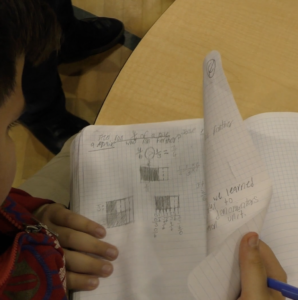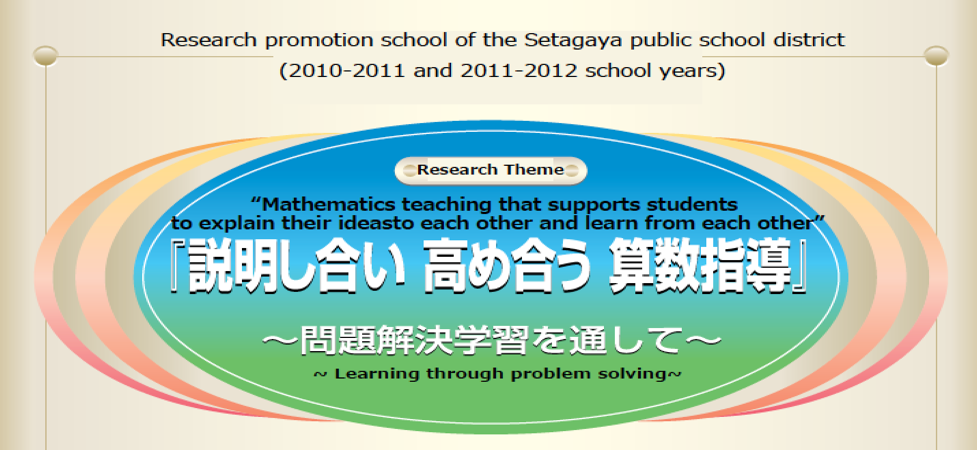This course for K-6 educators explores the power of student reflective journals in building students’ mathematical knowledge and practices.

Session 1: Explore the Inquiry Topic & Reflect on Your Current Practice
Outside-of-class meeting | Time: 1 hour | Materials: Recent Student Journals (class set) and board photographs for several recent lessons
Focus
Mathematicians express and communicate their ideas using models, expressions, and diagrams. Journal writing can help students can help students build fluency with the language of mathematics and connections across different representations, capacities at the core of many of the Common Core Standards for Mathematical Practices, including:
MP2: Reason abstractly and quantitatively. Writing in journals can help students move between abstract and concrete understandings of mathematics.
MP3: Construct viable arguments and critique the reasoning of others. Students use journals to work out their own ideas and to support them in explaining their ideas to others. Journals help students understand each other’s ideas, providing written work to supplement verbal explanation.
Click on the image below for a close-up of the student journal.

1A: Reflect on Your Current Practice
- Review your students’ journals. Do students routinely write mathematical expressions to go with their work? Do students routinely use the models and diagrams important to their grade level?
- Jot it down. What do you currently do to support students to write mathematical expressions and models and to make connections across them?
1B: Learn about New Strategies
Here are some strategies that you might try in order to support your students’ use of models, diagrams, and expressions:
- “Mind-reading”—Guess your classmate’s mathematical expression from looking at their diagram, counting method, or explanation). Guess your classmate’s solution method (how they counted, their drawing, etc.) from from reading their mathematical expression.
- Highlight journal entries that use the expressions, diagrams, etc. that you want the class to use, by featuring these to introduce the next day’s lesson.
- Consider what are the core models that you want students at different grade level. The following excerpt from the Matsuwaza Elementary School Report shows how the faculty focused and aligned core mathematical models for their students across the grades.

Note taking goals for lower grades |
Note taking goals for middle grades |
Note taking goals for upper grades |
|
Can write down what is written on the blackboard |
Can write down what teacher and others said |
Can write down points that they thought were important by listening to their friends way of thinking |
Diagram expression to instruct:
Can show the problem situation and the way of solving using symbols such as circles
Can show the relationship between addition and subtraction with a tape diagram (2nd grade)
Can show a series of whole numbers on a number line
Can show the composition and decomposition of numbers using the cherry diagram |
Diagram expression to instruct:
Can show the size of the number using a number diagram
Can show the relations between multiplication and division using a tape diagram and a number line.
Can show the series of decimal numbers and fractions on the number line
Can show the size of the quantity using the rectangular area model |
Diagram expression to instruct:
Can show the relationship between multiplication and division (decimal numbers and fractions) on the number line
Can show the relations between quantities on a table
Can combine the permutation and show it on a tree diagram |
Session 2: Try New Strategies in Your Classroom
In class | Time: 3-5 lessons over 1 to 2 weeks
- What specific changes do you plan to make in your classroom use of journals to help support your students’ use of models, diagrams, and expressions?
- What evidence will you look for to inform you about impact?
- For the next week (or approximately 3-5 lessons in which journals are being used), try out the strategies that you identified to support your students’ use of models, diagrams, and expressions.
- When possible, we recommend jotting down ideas after the lesson about your experiences and observations around the strategy that you tried.
- Prepare for the next session by collecting your notes and your students’ journals!
Session 3: Examine Evidence and Refine Your Plan
Outside-of-class meeting | Time: 30-60 minutes
3A: Examine Evidence from Lessons and Revise Plan
Examine student journal entries and read through any notes you jotted down as you were working to build students’ use of models, diagrams, and expressions. Reflection/Discussion questions:- What do you notice in students’ journals related to their use of models, diagrams, and expressions? For example, what do you notice about the frequency and quality of these mathematical features and the contexts that elicit them?
- What was successful and what was challenging as you worked to build students’ use of models, diagrams, and expressions?
- What strategies would you like to carry with you into your next week of instruction, and how would you like to modify these strategies (if at all)?
- What new strategy would you like to test our in the next week?
3B: Make a Plan for Your Second Round
- Note down the specific strategies you will try out over the next week (or next 3-5 lessons that use journals), to further build your students’ use of models, diagrams, and expressions in their journals
- Note down the evidence will you look for to gauge the impact of your work
Session 4: Test Your Refined Approach
In class | Time: 3-5 lessons over 1 to 2 weeks
For the next week (or approximately 3-5 lessons in which journals are being used), try out the refined strategies that you believe will further support your students’ use of models, diagrams, and expressions.- When possible, we recommend jotting down ideas after the lesson about your experiences and observations around the strategy that you tried
- Prepare for the next session by collecting your notes and your students’ journals!
Session 5: Examine Journals and Reflect on this Inquiry Cycle
Outside-of-class meeting | Time: 30-60 minutes
5A. Examine Student Journals, Read Notes, Reflect
Examine student journal entries and read through any notes you kept as you were working to build students’ use of models, diagrams, and expressions. Reflect on (or discuss) the following questions:- What do you notice in students’ journals related to their use of models, diagrams, and expressions? For example, what do you notice about the frequency and quality of these mathematical features and the contexts that elicit them?
- What was successful and what was challenging as you worked to build your students’ use of models, diagrams, and expressions?
- What strategies would you like to carry with you into your future instruction, and how would you like to modify these strategies (if at all)?
- What new strategy would you like to try?
5B. Reflect on this Inquiry Cycle
- What did you learn that might inform future inquiries–for example, how to collect data, collaborate, find useful resources, etc.
- Is there anything from this inquiry you would like to share more broadly at your school or with the profession? How will you do this?
